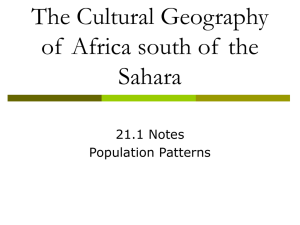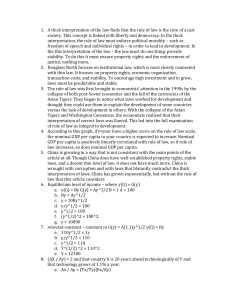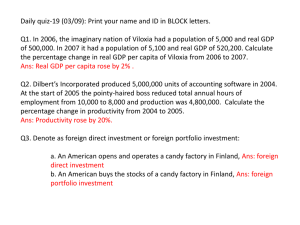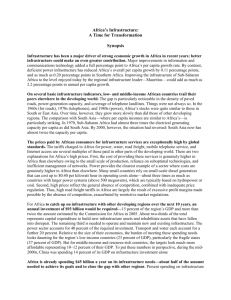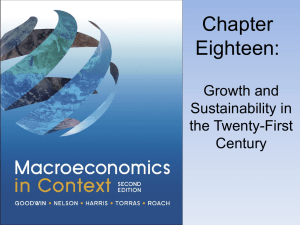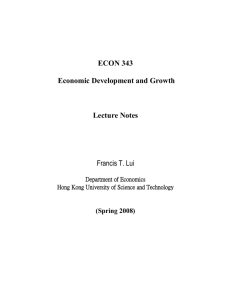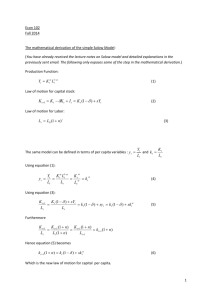ECON 120 ECONOMIC DEVELOPMENT
advertisement
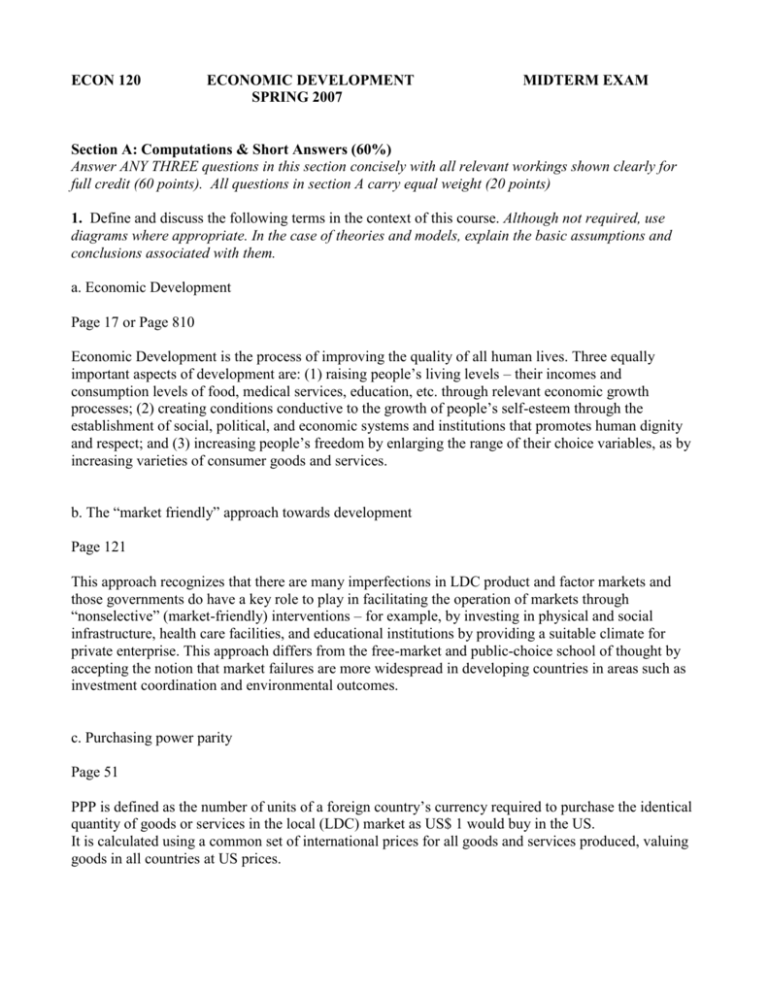
ECON 120 ECONOMIC DEVELOPMENT SPRING 2007 MIDTERM EXAM Section A: Computations & Short Answers (60%) Answer ANY THREE questions in this section concisely with all relevant workings shown clearly for full credit (60 points). All questions in section A carry equal weight (20 points) 1. Define and discuss the following terms in the context of this course. Although not required, use diagrams where appropriate. In the case of theories and models, explain the basic assumptions and conclusions associated with them. a. Economic Development Page 17 or Page 810 Economic Development is the process of improving the quality of all human lives. Three equally important aspects of development are: (1) raising people’s living levels – their incomes and consumption levels of food, medical services, education, etc. through relevant economic growth processes; (2) creating conditions conductive to the growth of people’s self-esteem through the establishment of social, political, and economic systems and institutions that promotes human dignity and respect; and (3) increasing people’s freedom by enlarging the range of their choice variables, as by increasing varieties of consumer goods and services. b. The “market friendly” approach towards development Page 121 This approach recognizes that there are many imperfections in LDC product and factor markets and those governments do have a key role to play in facilitating the operation of markets through “nonselective” (market-friendly) interventions – for example, by investing in physical and social infrastructure, health care facilities, and educational institutions by providing a suitable climate for private enterprise. This approach differs from the free-market and public-choice school of thought by accepting the notion that market failures are more widespread in developing countries in areas such as investment coordination and environmental outcomes. c. Purchasing power parity Page 51 PPP is defined as the number of units of a foreign country’s currency required to purchase the identical quantity of goods or services in the local (LDC) market as US$ 1 would buy in the US. It is calculated using a common set of international prices for all goods and services produced, valuing goods in all countries at US prices. 2. Consider the following data for Bolivia and Iran in 2006. Show clear and complete workings for full credit. Country Bolivia Iran Population Frying Pans (units) 20,000 4,000 12,000 9,000 Coffee (packets) 6,000 1,000 Price of FP per unit 25 BOB 10 IR Price of Coffee ton** 40 BOB 30 IR Exchange Rate: 1IR per 2BOB (i.e., 0.5IR per BOB) **Note that although coffee is sold in packets it is priced at a PER TON level. In this example 20 packets of coffee are equal to a ton. of coffee. a. Calculate and compare each country’s GDP per capita, expressed in 2006 IR, using the Exchange Rate Method. Are people in Bolivia richer than in Iran (use GDP per capita as a proxy for incomes)? Iran Bolivia Production of Frying Pans (Units) Price of Frying Pans per unit 9000 10 IR 4000 25 BOB Production of Coffee (Packets) Production of Coffee ™ (20 Packets = 1 TM) Price of Coffee per TM 1000 50 30 IR 6000 300 40 BOB Population Exchange Rate 12000 0.5 IR = 1 BOB GDP 20000 2 BOB = 1 IR 91500 IR 112000 BOB 91500 IR 7.63 IR 56000 IR 2.80 IR Exchange Rate Method GDP (IR terms) GDP per capita (IR terms) * Use the exchange rate to put both GDPs in the same currency. The GDP per capita of Iran is bigger than the GDP per capita of Bolivia. People in Iran are richer than in Bolivia b. Now, calculate each country’s GDP per capita in IR for 2006 using the PPP method. Is Bolivia’s per capita GDP bigger than the one of Iran? Why? Power Purchasing Parity Method: IR GDP per capita (IR terms) 7.63 IR Use vector of prices from Iran for the estimation of the GDP, so both GDPs will be in the same currency. 2.45 IR The GDP per capita of Iran is still bigger than the GDP per capita of Bolivia. Notice that the production of Frying Pans is bigger than the production of Coffee in both countries, and also the price of Coffee is bigger that the price of Frying Pans independent of the country (which may reveal similar quality), and assuming that both products are tradable, then the exchange rate and the PPP must have similar results. c. Now, calculate each country’s GDP per capita in BOB for 2006 using the PPP method. Is Bolivia’s per capita GDP bigger than the one of Iran? Why? Power Purchasing Parity Method: BOB GDP per capita (BOB terms) 18.92 BOB 5.60 BOB * Use only one vector of prices (Bolivia) for the estimation of the GDP, so both GDPs will be in the same currency. The GDP per capita of Iran is still bigger than the GDP per capita of Bolivia. As pointed out before, there are no problems with PPP method for estimation of production for comparison of countries if the goods are Tradables and the quality is pretty much the same (revealed by relative prices). 3. The following income distribution data are for Nigeria. Quintile Lowest 20% Second quintile Third quintile Fourth quintile Highest 20% Percent Share 1.5% 2.7% 7.8% 19.5% 68.5% Nigeria's total national income: $ 500 million per day Nigeria’s population: 100 million people a. Graph the Lorenz curve from the Nigerian data given above, carefully labeling the axes. On the axes, label all values that correspond to the five points that make up the Lorenz curve. Nigeria Lorenz Curve 100 Percentage of income 100 80 Lorenz curve 60 40 31.5 A 20 1.5 12.0 B 4.2 0 0 20 40 60 Percentage of income recipients 80 100 b. Show how to find the Gini coefficient, graphically (do not actually calculate it numerically). Gini coefficient = A / (A + B) in the previous graph. See Figure 5-3, page 200 for a similar definition. c. Suppose that each household makes the average income for its quintile (that is, assume that there is no inequality within quintiles). Using a poverty line of $1 per day per capita, what is the headcount (i.e. the measured number of poor people)? What is the average income shortfall (AIS)? Income Population 500000000 US$ 100000000 people People per quintile 20000000 20000000 20000000 20000000 20000000 Total income per quintile Income per capita 7500000 13500000 39000000 97500000 342500000 TPG 0.38 0.68 1.95 4.88 17.13 0.625 0.325 H = 40 million people AIS = [(0.625*20 million) + (0.325*20 million)]/40 million = 0.475 d. Suppose 5% of total national income were transferred from the highest-income quintile of households to the lowest-income quintile of households. Assume no other changes in the economy. What quantitative effect does this have on the headcount? Income Population 500000000 US$ 100000000 people People per quintile 20000000 20000000 20000000 20000000 20000000 Total income per quintile 7500000 13500000 39000000 97500000 342500000 Income per capita 5% Income 0.38 0.68 1.95 4.88 17.13 H = 20 million people (the second quintile becomes the poorest) 0.856 Tansfer to poor 1.2 0.7 2.0 4.9 16.3 4. The Solow neoclassical growth model. a. Compare and discuss the production function in the Harrod Domar model with the production function in the Solow model. Page 122 Y AK (Harrod-Domar production function) YK(AL )1 (Solow production function) The Solow model expanded on the Harrod-Domar formulation by adding a second factor, labor, and introducing a third independent variable, technology, to the growth equation. Unlike the fixed-coefficient, constant-return-to-scale assumption in the Harrod-Domar model, Solow’s neoclassical growth model exhibited diminishing returns to labor and capital separately and constant returns to both factors jointly. Technological progress became the residual factor explaining long term growth, and its level was assumed by Solow to be determined exogenously (independently of all other factors). b. What are the differences in the conclusions of the Solow model in a closed economy compared to an open economy? Page 122 Closed economies (those with no external activities) with lower saving rates (other things being equal) growth more slowly in the short run than those with high savings rates and tend to converge to lower per capita income levels. Open economies (those with trade, foreign investment, etc.), experience income convergence at higher levels as capital flows from rich countries to poor countries where capital-labor ratios are lower and thus returns on investment are higher. Section B: Essay Questions (40%) Answer any TWO questions in this section. Credit will be given for references to the non-textbook literature. All questions in section B carry equal marks (20 points each) 1. Using the production function approach, explain which factors are predominantly responsible for the large disparity in per worker output between North and South America? 2. Critically evaluate the models and policy recommendations of the dependency school. 3. Account for the post-1960 “neoclassical revival” in development thinking. 4. Critically evaluate some of the major policy recommendations that have been advanced to deal with poverty in third world countries. 5. Are high rates of population growth a drag on the development effort? Which policies should be advanced to deal with this problem? 6. What are the causes of rural urban migration? Should these flows be reduced? If so, what can be done to reduce these flows?
